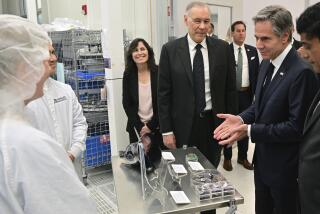S.D. Company on U.S.-Supported Technology Team
- Share via
SANTA CLARA — A San Diego company is part of a $25-million research pact with the federal government that is designed to encourage American companies to compete against Japanese firms working on the same technology.
Representatives of Intel Corp. and Ultratech Stepper, both of Santa Clara, and San Diego-based Jamar Technology Co., signed the agreement with the U.S. Department of Energy’s Lawrence Livermore National Laboratory.
Officials said the four-year pact, which will encourage the commercial development of “X-ray projection lithography,” could lead to computer chips that are 10 times faster and have 1,000 times more memory than any today.
“This technology potentially offers an approach for U.S. companies to ‘leapfrog’ their foreign competitors in producing computer chips,” said Livermore senior scientist Nat Ceglio. “It’s highly experimental, visionary. There’s a lot of risk involved.”
The DOE’s Office of Defense Programs will provide $12.6 million of the research money. The the three companies will provide a like amount.
Energy Secretary James Watkins, who attended the signing of the agreement at a technology conference in Santa Clara, said the public-private partnership “will give America a leg up on our global competitors.”
Intel is the nation’s largest manufacturer of microchips. Ultratech Stepper, founded in 1979, specializes in projection lithography. Jamar Technology, a subsidiary of California Jamar Inc., develops and builds high-intensity lasers.
David A. Markle, vice president of Ultratech Stepper, said the federal cooperation is critical. “This is a long-term research effort that, without the (Livermore) lab’s help, would not be undertaken,” he said.
Because of its research in defense and laser fusion programs, Livermore lab has made great headway in X-ray technologies. The public-private research effort is meant to apply that knowledge to the commercial manufacturing of microchips used in computers.
In manufacturing computer chips, companies have traditionally used visible light and, more recently, ultraviolet light, to transfer circuit patterns from a master pattern onto coated silicon wafers. Under the envisioned technology, X-rays, which have shorter wavelengths, would be used so that much smaller patterns can be imprinted.
Electronics firms today produce computer chips with line widths or feature sizes of 0.7 microns, or about 1/100th the width of a human hair. X-ray projection lithography may permit that size to be reduced to 0.05 microns by the year 2000, Ceglio said.
The first prototypes should be a available sometime in 1995 or 1996, Markle said.
More to Read
Inside the business of entertainment
The Wide Shot brings you news, analysis and insights on everything from streaming wars to production — and what it all means for the future.
You may occasionally receive promotional content from the Los Angeles Times.










